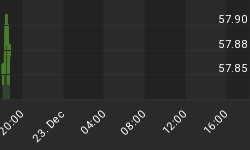Below is an excerpt from a commentary originally posted at www.speculative-investor.com on 30th July 2009.
The conventional wisdom has it that the massive foreign currency reserve held by China's government is primarily due to the US trade deficit, and that the US economy will be in big trouble should China ever decide to stop financing the trade deficit. As is often the case, this piece of conventional wisdom is wrong.
Here are the facts. First, the US economy is in big trouble, but the trouble has nothing to do with the trade deficit or the possibility that China's government will dump some of its US$ holdings (the causes of the US economic malaise have been detailed in previous TSI commentaries). Second, China does not "finance" the US trade deficit. What happens is that Chinese producers willingly send goods to the US in exchange for dollars. If the manufacturers of Chinese goods are dissatisfied with this arrangement then they have the choice of finding other customers or stopping production. Third, the extraordinary size of China's official foreign currency reserve ($2.1 trillion and growing, about 70% of which is US$-denominated) stems from the efforts that have been made over the years by China's government to 'manage' the Yuan's foreign exchange value. It works like this: A Chinese company exports some stuff to the US and receives dollars in return, but most of the company's costs are Yuan-denominated so the company trades these dollars for the local currency. When this is done on a large scale it puts upward pressure on the Yuan relative to the US$, which the Chinese Government wants to resist. The government therefore buys the dollars using newly-created Yuan, thus offsetting the upward pressure on the Yuan. In other words, to keep the Yuan/USD rate at a certain level the government of China adds to its USD reserves and simultaneously increases the Yuan supply. This not only has the effect of reducing the Yuan/USD rate to below where it would otherwise be, it also boosts prices within China. Fortunately or unfortunately, depending on how you look at it (Keynesians and Monetarists would say "fortunately" whereas members of the Austrian School would say "unfortunately"), the prices that have been affected to the greatest extent to date are the prices of investments (stocks, real estate and capital goods).
In summary, the huge currency reserve amassed by China's government is not a function of the US trade deficit; rather, it is a function of China's efforts to prevent the trade situation from increasing the relative value of the Yuan.
The conventional wisdom also has it that the economic stimulus program implemented by China's government has worked, as evidenced by data showing that its economy is again growing at a rapid pace.
The fact is that China's government has been able to create the ILLUSION of success by setting in motion a dramatic expansion of the money and credit supplies via the government-controlled banking system. Bad loans are being piled on top of bad loans and new mal-investments are being piled on top of earlier mal-investments, thus creating even more distortions within an economy that is already labouring under the distortions created by previous rampant credit expansion.
The following chart of China's M2 money supply tells an important part of the story. The chart has a semi-log scale, so a straight line on the chart would indicate a constant percentage rate of change. Notice that over the 9-year period leading up to the final quarter of last year the blue line representing M2 never deviated far from its long-term trend line (drawn in red), meaning that the M2 growth rate remained fairly constant throughout this period. Notice, as well, that the blue line has since moved well above its long-term trend. The slope of the red line represents annual growth of 16%-17%, which is very high but pales in comparison with the current annual growth rate of 28%.

Chart Source: www.fullermoney.com
A sustainable increase in consumption must be preceded by an increase in production (it is production, not consumption, that drives real economic growth), but the corollary is not true in the situation where the government encourages the economy to produce more of something for which there is no end market. When increased production is prompted by government directives and/or the creation of money/credit out of nothing, the thing that will end up being consumed is the invested capital.
By throwing huge sums of money around and by forcing banks to lend as if there were no tomorrow, China's government has stimulated investment in factories, real estate and the stock market at a time when existing factories are shutting down in droves, rental yields are very low and the development of new real-estate projects is running well ahead of sustainable demand, and the stock market is priced for perfection. We can be sure that this story will end very badly, we just don't know when.
We aren't offering a free trial subscription at this time, but free samples of our work (excerpts from our regular commentaries) can be viewed at:http://www.speculative-investor.com/new/freesamples.html.
















